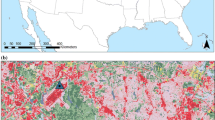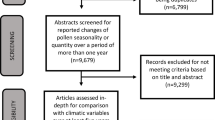Abstract
Major weather parameters have long been known to alter airborne pollen and spore concentrations. The following study was conducted to study the effect of three of these parameters on airborne ragweed pollen concentrations.During the ragweed (RW) season for the years 1997 and 1998, 10 minute pollen collections were taken at least every 4 hours using an Allergenco MK-3 spore trap. Slides were fixed, and counted microscopically at 400X. During this same period, weather parameters were monitored by an Automated Weather Systems recording station located within a few meters of the collector.The ragweed season for this region begins in mid August and ends by mid October. Temperature patterns for the period demonstrated usual daily fluctuations with highs 13 to 35 °C and lows 8 to 24 °C. Relative humidity readings for the period varied between 25 and 100%. Highest RW values were seen after seasonal cooling in September. Daily rainfall for the period varied between 0 and 100 mm. Airborne RW always declined sharply after strong rainfall events (> 10 mm/day). Peak airborne RW concentrations were often associated with the passing of frontal boundaries and the change in wind direction and velocity that accompanies that passing.Factors influencing airborne RW concentrations are multiple and complex, but atmospheric forces have great influence. The passing of major weather fronts and the associated temperature drops, wind disturbances and rainfall are the major factors.
Similar content being viewed by others
References
Bianchi D., Schwemmin D. and Wagner W.: 1959, Pollen release in common Ragweed (Ambrosia Artimesifolia). Botanical Gazzet 4, 253.
Cage B., Schreiber K., Barnes C. and Portnoy J.: 1996, Evaluation of four bioaerosol samplers in the outdoor environment. Ann Allergy 77, 1–7.
Comtois P. and Boucher S.: 1996. Phenology and aerobiology of short ragweed (Ambrosia artemisiifolia) pollen. In: M. Muilenberg and H. Burge (eds), Aerobiology. CRC Press CRC Press, Lewis Publishers, New York, pp. 17–26.
Comtois P. and Sherknies D.: 1992, Ragweed pollen (Ambrosia artemisiifolia L.): prediction and prevention. Allerg Immunol (Paris) 24, 22–26.
Emberlin J. and Norris-Hill J.: 1996, The influence of wind speed on the ambient concentrations of pollen from Gramineae, Plantus and Betula in the air ofLondon, England. In: M. Muilenberg and H. Burge (eds), Aerobiology. CRC Press CRC Press, Lewis Publishers, New York, pp. 27–38.
Frenz DA.: 1999, Volumetric ragweed pollen data for eight cities in the continental United States. Ann Allergy Asthma Immunol 82(1), 41–46.
Ogden E., Hayes J. and Raynor G.: 1969, Diurnal patterns of pollen emission in Ambrosia, Phleum, Zea and Ricinus. American Journal of Botany 56, 16–21.
Ogden E. and Raynor G.: 1960, Field evaluation of ragweed pollen samplers. Journal of Allergy 31, 307–316.
Portnoy J., Landuyt J., Pacheco F., Flappan S. and Barnes C.: 1999, A Comparison of the Burkard and Allergenco MK-3 Volumetric Collectors. Annals of Allergy, Asthma and Immunology, in Review.
Raynor G. and Hayes J.: 1970, Experimental prediction of daily ragweed concentration. Ann Allergy 28, 580–585.
SolomonW. and Mathews K.: 1990, Aerobiology and inhalant allergens. In: Middelton Reed, Ellis Adkinson and Yunginger (eds), Allergy Principles and Practice, Volume 1 Third edition. Mosby, St Louis, pp. 312–372.
Author information
Authors and Affiliations
Rights and permissions
About this article
Cite this article
Barnes, C., Pacheco, F., Landuyt, J. et al. The effect of temperature, relative humidity and rainfall on airborne ragweed pollen concentrations. Aerobiologia 17, 61–68 (2001). https://doi.org/10.1023/A:1007693032090
Issue Date:
DOI: https://doi.org/10.1023/A:1007693032090




